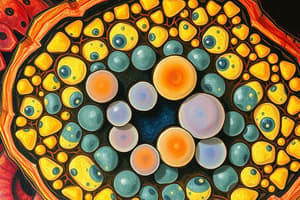Podcast
Questions and Answers
What is the primary function of the nucleus in a cell?
What is the primary function of the nucleus in a cell?
The nucleus controls cellular activities and gene expression by containing DNA.
How do ribosomes contribute to protein synthesis?
How do ribosomes contribute to protein synthesis?
Ribosomes are the sites where proteins are synthesized, either free in the cytoplasm or attached to the endoplasmic reticulum.
What are the main differences between smooth and rough endoplasmic reticulum?
What are the main differences between smooth and rough endoplasmic reticulum?
Smooth ER synthesizes lipids and detoxifies toxins, while rough ER is studded with ribosomes and synthesizes proteins.
Describe the role of the Golgi apparatus in the cell.
Describe the role of the Golgi apparatus in the cell.
What is the significance of mitochondria for the cell?
What is the significance of mitochondria for the cell?
Explain how chloroplasts function in plant cells.
Explain how chloroplasts function in plant cells.
What role do lysosomes play in cellular maintenance?
What role do lysosomes play in cellular maintenance?
How do vacuoles contribute to the function of plant cells?
How do vacuoles contribute to the function of plant cells?
What is the function of the cytoskeleton in a cell?
What is the function of the cytoskeleton in a cell?
Identify a key difference between plant and animal cells based on their organelle composition.
Identify a key difference between plant and animal cells based on their organelle composition.
Flashcards are hidden until you start studying
Study Notes
Cell Organelles
-
Definition: Cell organelles are specialized structures within cells that perform distinct functions necessary for cellular maintenance and activities.
-
Major Organelles:
-
Nucleus:
- Contains DNA, the genetic material.
- Controls cellular activities and gene expression.
-
Ribosomes:
- Sites of protein synthesis.
- Found free in the cytoplasm or attached to the endoplasmic reticulum.
-
Endoplasmic Reticulum (ER):
- Smooth ER: Synthesizes lipids and detoxifies toxins.
- Rough ER: Studded with ribosomes; synthesizes and processes proteins.
-
Golgi Apparatus:
- Modifies, sorts, and packages proteins and lipids for secretion or delivery to other organelles.
-
Mitochondria:
- Known as the "powerhouse" of the cell.
- Produces ATP through cellular respiration.
-
Chloroplasts (in plant cells):
- Site of photosynthesis.
- Converts solar energy into chemical energy (glucose).
-
Lysosomes:
- Contain digestive enzymes.
- Break down waste materials and cellular debris.
-
Peroxisomes:
- Breakdown of fatty acids and detoxification.
- Produce hydrogen peroxide as a byproduct.
-
Vacuoles:
- Store nutrients, waste products, and help maintain turgor pressure in plant cells.
-
Cytoskeleton:
- Network of fibers that provide structural support.
- Involved in cell movement and transport of materials.
-
-
Additional Structures:
- Plasma Membrane: Semi-permeable membrane that controls movement in and out.
- Cell Wall (in plant cells): Provides rigidity and protection.
-
Functionality:
- Organelles work together to maintain homeostasis, provide energy, support growth, and facilitate reproduction in cells.
-
Differences in Plant and Animal Cells:
- Plant cells have cell walls, chloroplasts, and larger central vacuoles; animal cells have lysosomes and more varied cell shapes.
Cell Organelles
- Specialized structures within cells responsible for essential cellular functions
- Each organelle has a distinct role, contributing to overall cell maintenance and activities
Nucleus
- Contains DNA, the cell's genetic blueprint
- Controls cellular functions by directing gene expression
Ribosomes
- Sites of protein synthesis
- Found free in the cytoplasm or attached to the endoplasmic reticulum (ER)
Endoplasmic Reticulum (ER)
- Smooth ER: synthesizes lipids, detoxifies toxins
- Rough ER: studded with ribosomes, synthesizes and processes proteins
Golgi Apparatus
- Modifies, sorts, and packages proteins and lipids
- Prepares them for secretion or delivery within the cell
Mitochondria
- Known as the "powerhouse" of the cell
- Produces ATP, the cell's energy currency, through cellular respiration
Chloroplasts
- Found in plant cells
- Site of photosynthesis: converting solar energy into chemical energy (glucose)
Lysosomes
- Contain digestive enzymes
- Break down waste materials and cellular debris for recycling or removal
Peroxisomes
- Breakdown of fatty acids and detoxification
- Produce hydrogen peroxide as a byproduct
Vacuoles
- Store nutrients, waste products, and water
- Help maintain turgor pressure in plant cells
Cytoskeleton
- Network of fibers providing structural support
- Involved in cell movement and transport of materials
Plasma Membrane
- Semi-permeable membrane controlling movement of substances into and out of the cell
Cell Wall
- Found in plant cells
- Provides rigidity and protection
Functionality
- Interacting organelles maintain homeostasis, provide energy, support growth, and facilitate cell reproduction
Differences in Plant and Animal Cells
- Plant cells have cell walls, chloroplasts, and larger central vacuoles
- Animal cells have lysosomes and exhibit more varied cell shapes
Studying That Suits You
Use AI to generate personalized quizzes and flashcards to suit your learning preferences.




